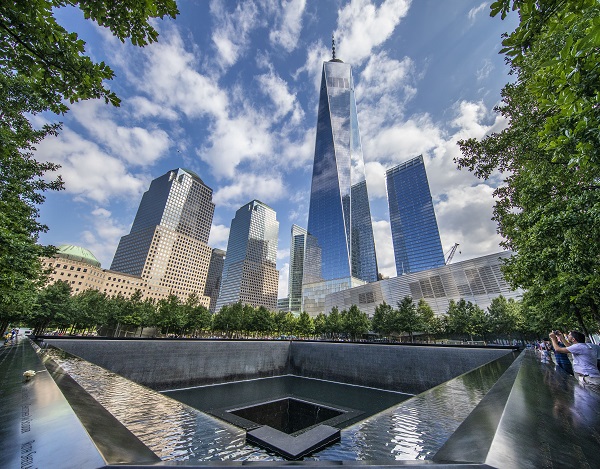Years Before 9/11, WTC Security Experts Prepared for Y2K
Years Before 9/11, WTC Security Experts Prepared for Y2K

As the year 2000 approached, many were concerned that the date change from 12/31/99 to 1/1/00 would cause problems with technology, potentially disrupting everything from company computer networks, to power grids, to security systems. These concerns were referred to collectively as “Y2K,” a shorthand for the year 2000.
Businesses spent months upgrading and testing their computer systems to make sure they were “Y2K compliant,” and that their clients would not experience any interruption in service when the clock struck midnight on Jan. 1, 2000. The 9/11 Memorial Museum collection features artifacts and oral histories that relate to Y2K including remembrances of Richard Cyril Rescorla, whose preparations in advance of Y2K were credited with saving lives on 9/11.
In the end, Y2K caused only minor problems. But the extensive preparations and upgrades meant that companies entered the new millennium equipped and staffed to deal with the rapid technological growth that would greet them in the 21st century. The security preparations are also thought to have assisted with evacuation efforts when the World Trade Center was attacked on Sept. 11, 2001.
One company in the World Trade Center, Morgan Stanley Dean Witter (now known simply as Morgan Stanley), was especially invested in ensuring the stability and security of their computer networks. As an investment bank handling global financial transactions, the company’s senior management grew concerned that any interrupted or malfunctioning technology could cause the stock market to react negatively. So in the early months of 1999, they began a months-long process of bracing for potential technology failure that they might face on New Year’s Eve.
One professional who was on the case was Vice President of Security Richard Cyril Rescorla, a veteran of the British Army and U.S. Army who was known for his commitment to the safety of his colleagues. After witnessing vulnerabilities and evacuation issues in the aftermath of the 1993 World Trade Center bombing, Rescorla stepped up efforts to make sure that his colleagues were fully trained on emergency protocols, leading an extensive drill twice a year.
His vigilance was on display during the company’s Y2K efforts, as he worked closely with information technology and security staff to ensure that the transition went smoothly and that the building’s security systems remained functional. A coworker, Dan Fitzpatrick, remembered Rescorla’s contributions to Morgan Stanley’s Y2K efforts in a 2011 oral history.
“I particularly got to know Rick during Y2K. It was a big deal, particularly for a big financial company. And Rick was particularly concerned. We set up a bunker in 5 World Trade Center as our command center, and for about three weeks over the Y2K period, before and after, I really was attached to the hip with Rick. And I remember, it was before business casual dress, and Rick always wore a suit and tie to work. And then it was New Year’s Eve of Y2K, and all of a sudden Rick comes in, and I believe his son Trevor was with him that night. And they came in and they had these black pants and long-sleeved black shirts on. They looked like ninja warriors almost, it was so funny to see Rick that way, because he was always in a suit and tie and always very formal. They were going around all through the World Trade Center, every floor. They kept inspecting it all night to see if anyone was around that could cause a problem."
New Year’s Eve came and went, and the company’s systems hummed along uninterrupted. Relieved and triumphant, Morgan Stanley Dean Witter hosted a Y2K party for their staff to commemorate a job well done. The attendees wore custom hats and jackets created for the project emblazoned with the words “MSDW Y2K Team.” Rick Rescorla even performed in a skit, alongside his “bunker” teammates.
Less than two years later, Rescorla’s commitment to his company’s security would be tested. On 9/11, he was seen leading his coworkers out of the World Trade Center, singing traditional Cornish songs from his childhood through a bullhorn. He had gone back into the buildings to look for anyone left behind when the South Tower collapsed. More than 3,700 of his colleagues managed to escape. Rescorla, however, became one of 13 Morgan Stanley employees or contractors killed in the attacks. Because of his commitment to emergency preparedness and his leadership on that morning, he is credited with saving thousands of lives.
An MSDW Y2K Team baseball cap was donated to the 9/11 Memorial Museum collection in memory of Nicholas Craig Lassman. Lassman worked as a golf instructor in Florida while teaching himself to program, eventually becoming skilled enough to earn a position at Morgan Stanley Dean Witter.
Not long after the company’s Y2K preparations concluded, he moved to a position at the Cantor Fitzgerald subsidiary eSpeed, a groundbreaking electronic bond trading startup based on the 103rd floor of the World Trade Center’s North Tower. With offices above the impact zone of hijacked Flight 11, Nicholas Lassman was one of the 658 Cantor Fitzgerald employees killed on 9/11.
By Kirsten Madsen, Memorial Exhibition Assistant Manager, 9/11 Memorial Museum
Previous Post
VICE Correspondent Discusses Reporting from Raqqa

VICE correspondent Isobel Yeung spoke at the 9/11 Memorial Museum this week about her recent reporting from conflict zones in the Middle East.
Next Post
2018 at a Glance at the 9/11 Memorial & Museum

A review of events and other notable developments at the 9/11 Memorial & Museum in 2018.